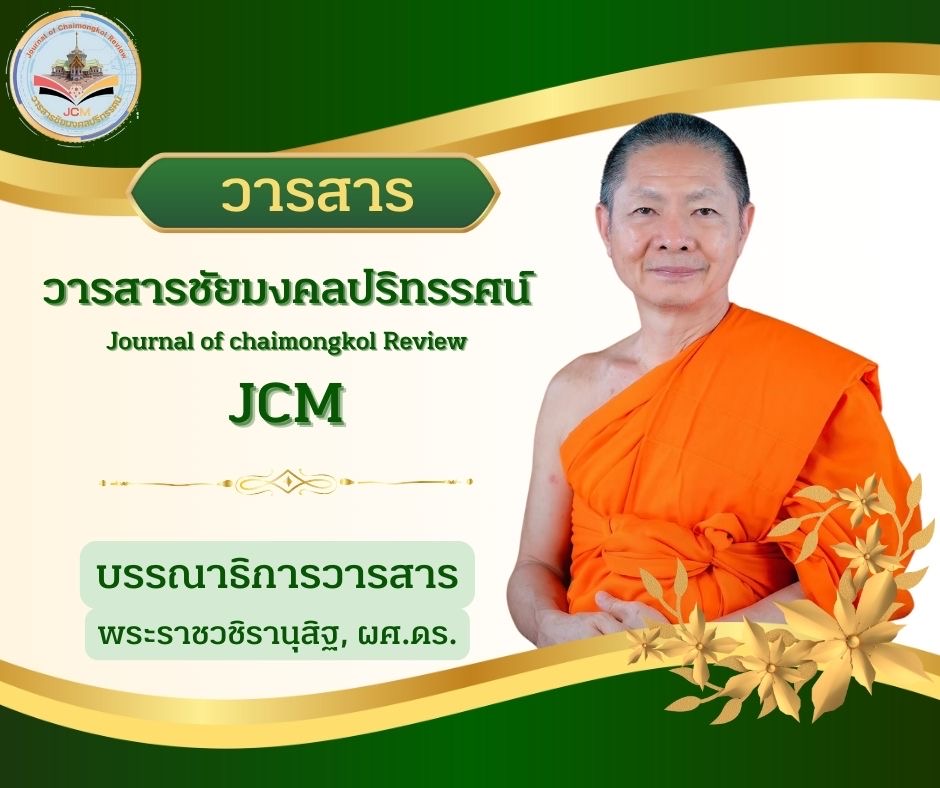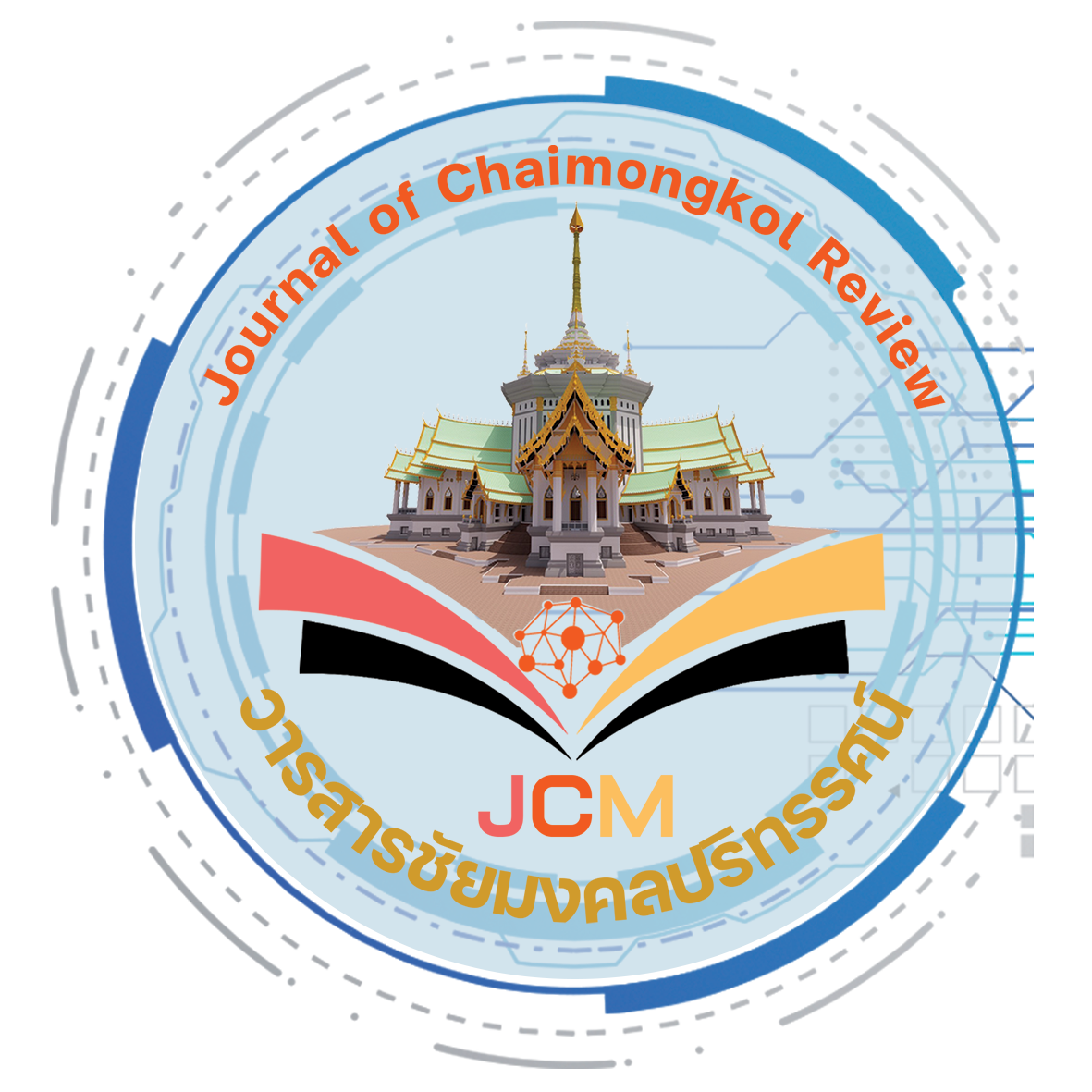CODE OF BUDDHADAHMMA: YANTRA SOLASA IN WAT NA PHRA MERU IN AYUTTHAYA
Keywords:
Buddhist scriptures, Yan Soros, Wat Phra Na Phra MeruAbstract
This article aims to study the talisman at Wat Mueang. Phranakhon Si Ayutthaya To reflect on the Buddha's meaning, which appears in the Talisman. Use the study methodology of relevant papers and research.
The research found that the Talons were in front of the temple. Both are beliefs about the Yue that are related to sacred beliefs. It appears that the temple was not burned in the Ayutthaya period, making Yan a symbol of holiness until it was built in the Rattanakosin period of King Rama I to put the inscription to the city in the time of the town. In addition, the talisman is used when removing the meaning of numbers. The letter will show the concept of doctrine and doctrine in Buddhism. Still, the number of categories, such as high-class three-layer tales, is down to 16 numbers (Soros means 16 blue sky means. The landscape of the landscape is the residence of Brahma 16 floors and refers to the Buddha. Greetings of the Lord Buddha, 16), bringing together three types of talisman. The numbers are replaced with the auspicious meaning in the middle of the small box, which is 9 yen. And the outmost is the noble Tris. Then, the outer character that surrounds the talisman is the spell of charisma 30, etc.
References
กิตติพัฒน์ เพ็ชรทองนะ. (2551). การตั้งชื่อยันต์ของคนไทย (วิทยานิพนธ์ปริญญามหาบัณฑิต). กรุงเทพฯ: มหาวิทยาลัยศิลปากร.
ณัฐธัญ มณีรัตน์ และ ชานป์วิชช์ ทัดแก้ว. (2561). องค์พระและสูญนิพพานในคัมภีร์ตรีนิสิงเห. วารสารพุทธศาสน์ศึกษา จุฬาลงกรณ์มหาวิทยาลัย, 25(3), 8-26.
ณัฐธัญ มณีรัตน์ และ ชานป์วิชช์ ทัดแก้ว. (2562). ความสำคัญของระบบเลขในคัมภีร์ตรีนิสิงเห. วารสารอักษรศาสตร์, 48(1), 144-161.
ณัฐธัญ มณีรัตน์. (2560). คัมภีร์ตรีนิสิงเห: การตรวจสอบชำระและบทบาทในสังคมไทย (วิทยานิพนธ์ปริญญาดุษฎีบัณฑิต). กรุงเทพฯ: จุฬาลงกรณ์มหาวิทยาลัย.
ดิเรก ด้วงลอย. (2563). ประวัติศาสตร์ท้องถิ่นบ้านสวน จังหวัดสุโขทัย. สุโขทัย: กองทุนพระครูสุพัฒนพิธาน (ทองดี มหาวีโร).
เทพย์ สาริกบุตร. (2501). พระคัมภีร์พระเวทฉบับจัตตุถบรรพ. กรุงเทพฯ: อุตสาหกรรมการพิมพ์.
ธีรโชติ เกิดแก้ว. (2555). การศึกษาเชิงวิเคราะห์สัญลักษณ์ทางพระพุทธศาสนาที่ปรากฏในยันต์ไทย. วารสารพุทธศาสน์ศึกษา, 19(2), 55-72.
พระครูสิริปริยัตยานุศาสก์, และคณะ. (2562). ความเชื่อเรื่องยันต์ในล้านนาจากมุมมองพระพุทธศาสนา. วารสารมหาจุฬานาครทรรศน์, 6(4), 1999-2022.
พระพิษณุพล สุวณฺณรูโป (รูปทอง). (2554). การศึกษาหลักพุทธธรรมและคุณค่าที่ปรากฏในยันต์เทียนล้านนา: กรณีศึกษาเฉพาะในเขตอำเภอเมือง จังหวัดลำปาง (วิทยานิพนธ์ปริญญามหาบัณฑิต). พระนครศรีอยุธยา: มหาวิทยาลัยมหาจุฬาลงกรณราชวิทยาลัย.
วรรณิษา อภัยรัตน์. (2556). จัตุรัสกลกับยันต์ล้านนา. สงขลา: ภาควิชาคณิตศาสตร์และสถิติ คณะวิทยาศาสตร์ มหาวิทยาลัยสงขลานครินทร์.
วัชรี สวามิวัศดุ์ (บรรณาธิการ). (2559). วัดพระเมรุราชิการาม (พิมพ์ครั้งที่ 3). กรุงเทพฯ: แกลเลอรี่การพิมพ์.
วานิษา บัวแย้ม. (2556). ศึกษาแนวคิดยันต์รูปตัวละครรามเกียรติ์ (รายงานการวิจัย). กรุงเทพฯ: คณะโบราณคดี, มหาวิทยาลัยศิลปากร.
วิลักษณ์ ศรีป่าซาง. (2558). คง เข้ม ข่าม ขลังเครื่องรางล้านนา. วารสารราชมงคลล้านนา, 3(1), 13-27.
สิโรตม์ ภินันท์รัชต์ธร. (2561). จิตรกรรมภาพยันต์ตรีนิสิงเห เพดานหอพระไตรปิฎก วัดป่าไผ่อำเภอโพธาราม จังหวัดราชบุรี. วารสารไทยคดีศึกษา, 15(1), 47-96.
อติชาต เกตตะพันธุ์, และคณะ. (2554). คณิตศาสตร์ในระบบเลขยันต์ล้านนา. เชียงใหม่: ภาควิชาคณิตศาสตร์ คณะวิทยาศาสตร์ มหาวิทยาลัยเชียงใหม่.
อัญชลี กิ๊บบิ้นส์. (2559). ยันต์ ความพันผูกทางพุทธธรรมภาษา และศิลปะ. วารสารข่วงผญา สำนักศิลปะและวัฒนธรรม มหาวิทยาลัยราชภัฏเชียงใหม่, 11, 169-202.
Chean, R. M. (2002). The changing religious beliefs and ritual practices among Cambodians in diaspora. Journal of Refugee Studies, 15(2), 222–233.
Cummings, J. (2011). Sacred tattoos of Thailand: Exploring the masters, magic and mystery of Sak Yan. Singapore: Marshall Cavendish.
De La Loubère, S. (2014). Chod mai het La Loubère: Racha anachak Siam. Nonthaburi: Sri Panya. (Original work published 1691)
Demeterio III, F. P. A., Calimag, J., Zafra, B., & Ambion, L. A. (2016). The traditional tattoos of the Philippine Cordillera region: A study on their differences in appearance, causes and discursive strengths.
Drouyer, I., & Drouyer, R. (2013). Thai magic tattoos: The art and influence of Sak Yant. River Books.
Drouyer, I., & Drouyer, R. (2017). Tatouages sacrés, Thaïlande, Cambodge, Laos et Myanmar. Un tatouage peut-il changer votre vie? Soukha Editions.
Gamborg, D. J. (2012). Japanese traditional tattooing in modern Japan (Master's thesis, University of Oslo, Norway). https://www.duo.uio.no/bitstream/handle/10852/24212 /Gamborg.pdf?sequence=3&isAllowed=y
Harris, I. (2008). Cambodian Buddhism: History and practice. Honolulu: University of Hawai'i Press.
Igunma, J. (2008). Human body, spirit and disease; the science of healing in 19th century Buddhist manuscripts from Thailand. The Journal of the International Association of Buddhist Universities, 1, 120–132.
Krutak, L. (2014). Tribal tattoos of Indonesia: An ancestral art. Paris and Arles: Musée du Quai Branly and Actes Sud.
Oo, M. M. (2016). Tattoo art in Myanmar culture: Special reference with state bondsmen of cavalry corps. Ministry of Education, Myanmar. https://www.researchgate.net /publication/331649896
Prateepavanich, S. (2015). The development of fashion from the beliefs and amulets of Thailand. Veridian E-Journal, Silpakorn University International (Humanities, Social Sciences and Arts), 8(5), 59-73.
Rivers, V. Z. (2004). Layers of meaning: Embellished cloth for body and soul. New Delhi: Wisdom Tree.
Stephenson, H. (2019, January 29). The changing status of tattoos in Vietnamese society. The Culture Trip. https://theculturetrip.com/asia/vietnam/articles/the-changing-status-of-tattoos-in-vietnamese-society/
Swearer, D. K. (2004). Becoming the Buddha: The ritual of image consecration in Thailand. Princeton University Press.
Tharmar, N. M. (2015). A pilot study on tattooing culture in Peninsular Malaysia. Management and Science University. https://www.researchgate.net/publication/283258840







